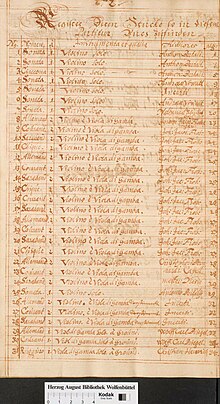Score book Ludwig
The score book Ludwig is a collection of 114 instrumental pieces from the 17th century that the Gotha musician and writer Jakob Ludwig (1623–1698, also Jacobo Ludovico) wrote to his former employer, Duke August II of Braunschweig-Wolfenbüttel, on his 83rd birthday on 10th. April 1662 presented.
Background and origin
Duke August II (1579–1666) was an avid art lover throughout his life and is considered one of the most learned princes of his time. He was particularly interested in manuscripts and books, which explains his strong collecting activity. They created what was then the largest library in Europe, the Herzog August Library .
The manuscript of the score book was originally intended for this library, as the artful, almost calligraphic design underlines. It was unusable for music practice, had the character of an art book from the start and was made as a collector's item.
It is not known over what period of time Jakob Ludwig created the collection, nor what sources he used. The neighboring royal courts of Eisenach , Weimar and Arnstadt come into question . What is certain, however, is how the connection between Jakob Ludwig and his prince came about: from 1647 to 1652 he was employed as a tenor in the duke's service. It is possible that he was commissioned to carry out the collection by the princess's musical wife, Princess Sophie Elisabeth .
Content and structure
The 114 compositions of the score book can be divided into two parts: 108 pieces of music arranged according to the number of instruments involved (1–8) and six rather loosely appended trio sonatas . The manuscript is concluded by a three-page “register of those pieces that can be found in this score for books”.
The first part begins with violin solo sonatas and ends with an eight-part sonata . The cover sheet of the Codex states as the corresponding content “Sonatas, Canzones , Arias , Allemand [en] , Cour [anten] , Sarab [andes] , Chiquen etc. Mitt. Instruments ".
With at least 17 works, Antonio Bertali is the most common composer in the score book. In addition to music by Johann Heinrich Schmelzer, there are also compositions by lesser-known composers from Thuringia and Saxony, such as Johann Michael Nicolai or Clementis, who could be Clemens Thieme (1631–1668) from Dresden . Other compositions come from Adam Drese , known as a hymn composer , from Samuel Capricornus and Nathanael Schnittelbach , among others .
Among the compositions of the first part there are also two works by Heinrich Bach (1615–1692), an ancestor of Maria Barbara Bach , Johann Sebastian Bach's first wife , under the numbers 92 and 93 . Due to an essay by Ulrich Konrad , which appeared in the Bach year 1995 and dealt with these instrumental pieces, the score book Ludwig once again aroused interest in music practice.
The second part consists mainly of trio sonatas by the Weimar-Eisenach organist Andreas Oswald .
meaning
For a long time the instrumental music of the 17th century north of the Alps was adequately represented by mainly three sources: the extensive Dübensammlung , the Kromeriz collection and the Codex Rost compiled by Franz Rost. The score book Ludwig, however, makes an equally important contribution because it is independent. After all, its overlap with the other three sources is extremely small. It is the only source for some works, for example for the double-choir Sonata Tubicinum by Johann Heinrich Schmelzer. The same applies to the instrumental compositions by Christoph Bernhard .
The score book offers a broad overview of the predominantly German instrumental music from the middle of the 17th century. The composers involved worked in Weimar (Adam Drese), Stuttgart (Johann Michael Nicolai, Samuel Capricornus) and Lübeck (Nathanael Schnittelbach), but also in Vienna (Antonio Bertali, Johann Heinrich Schmelzer). In addition, it proves the rapid spread of individual pieces of music such as the Sonata Concertata by Dario Castello , but also the independent German reception of the violin art of the Monteverdi School .
Web links
- The music collection of the Herzog August Library
- Michael Fuerst: The Partiturbuch Ludwig: An Introduction and Thematic Catalog . In: The Viola da Gamba Society Journal. Vol. 4, 2010, pp. 74–102 (PDF file; 6.9 MB)
Individual evidence
- ↑ See the dedication on the cover of the score book Ludwig in the Wolfenbüttel digital library
- ↑ See the index of the Ludwig score book in the Wolfenbüttel digital library
- ↑ To the cover sheet of the score book Ludwig in the Wolfenbüttel digital library
- ↑ z. B. with his quite popular Ciacconna (Youtube video with Veronika Skuplik and the Ensemble L'Arpeggiata)
- ↑ See page 186 of the Ludwig score book in the Wolfenbüttel digital library
- ↑ See page 188 of the Ludwig score book in the Wolfenbüttel digital library

